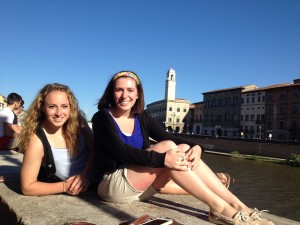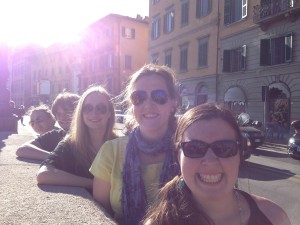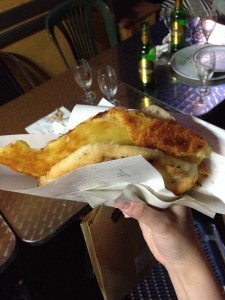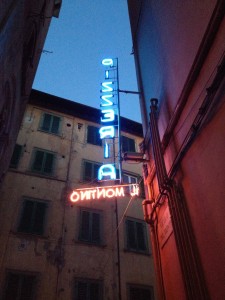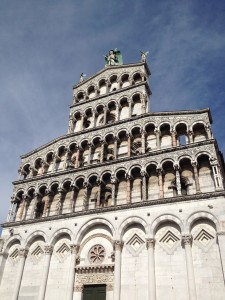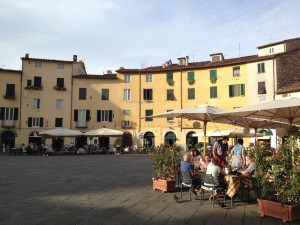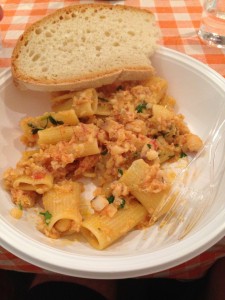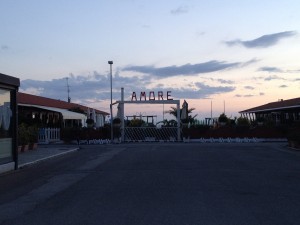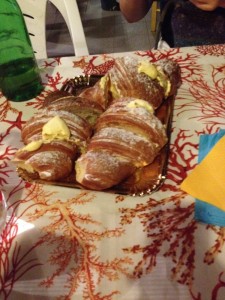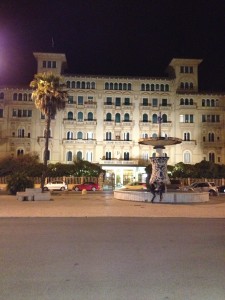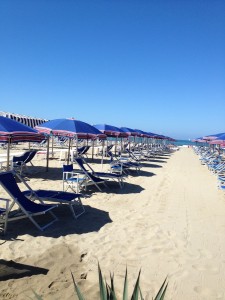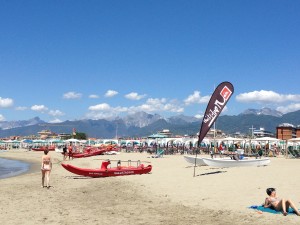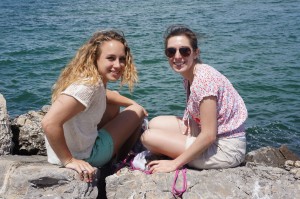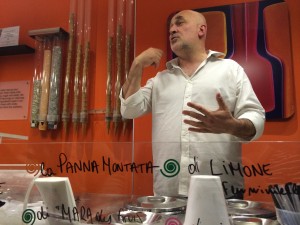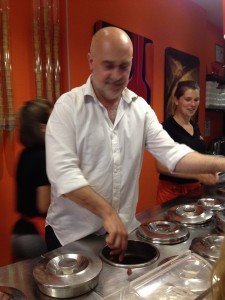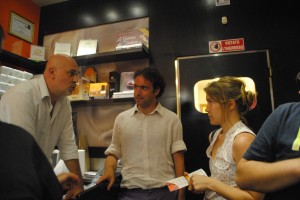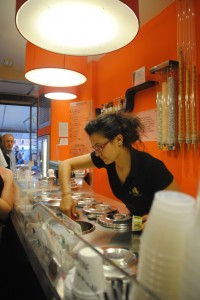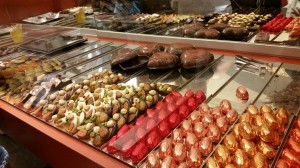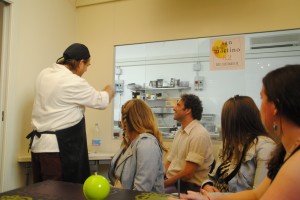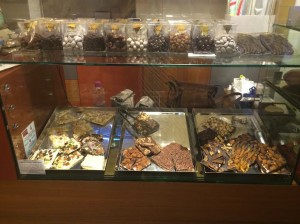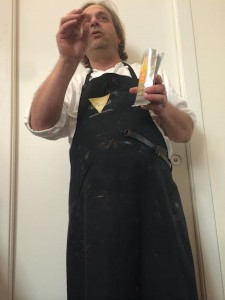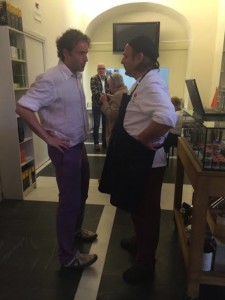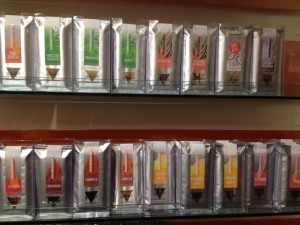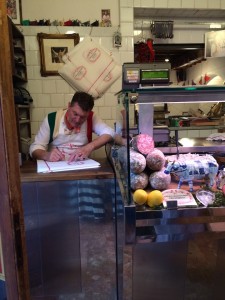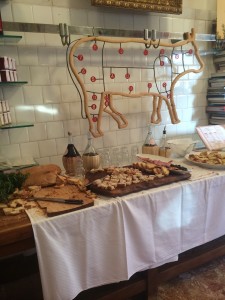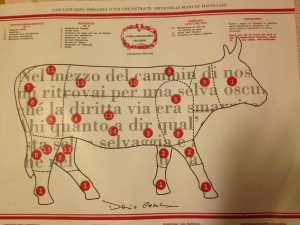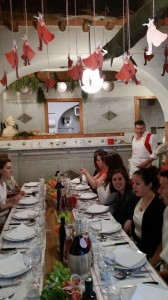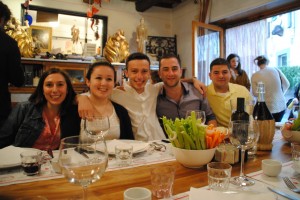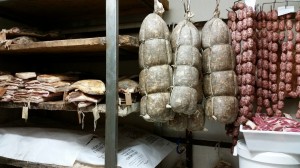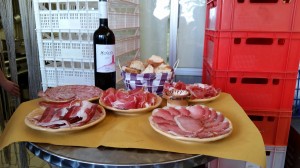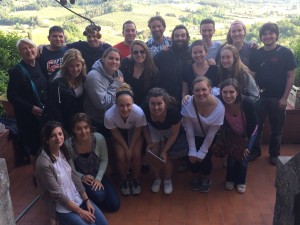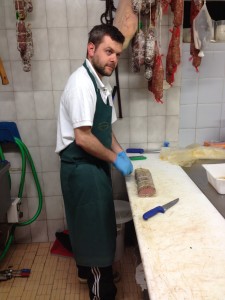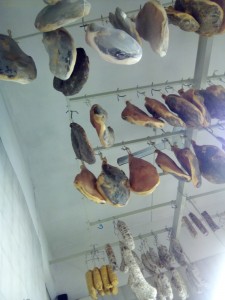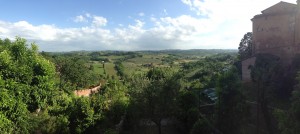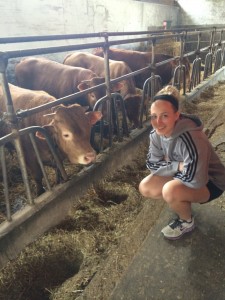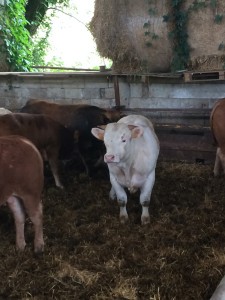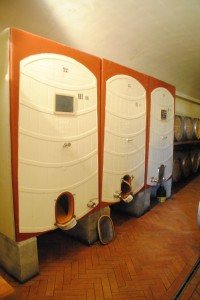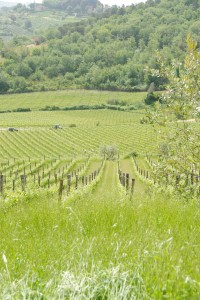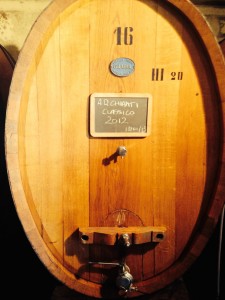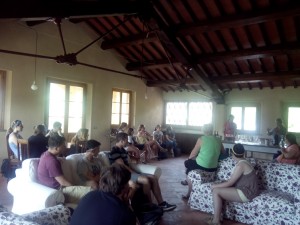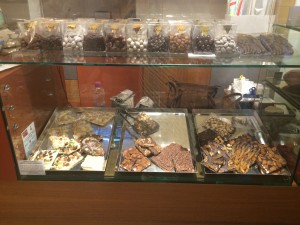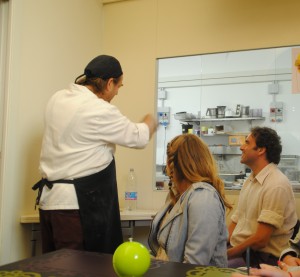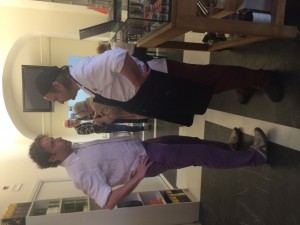
Audience Navigation
Utility Navigation
Lucca — Sunday May 24, 2014
June 11th, 2014 by aborghinViareggio — Saturday and Sunday, May 24-25, 2014
June 11th, 2014 by aborghinWhile in Viareggio, we had some days of fair weather at the beach and a dinner at Prof. Borghini’s house, where his parents and his sister prepared us a typical home meal, with pasta trabaccolara, salad, melon and prosciutto (from Macelleria Falaschi), sausages (from Macelleria Falaschi), and gigantic croissants filled with cream from Camaiore.
Gelateria De’ Coltelli — Saturday May 24, 2014
June 11th, 2014 by aborghinWhile in Pisa, we visited also the gelateria De’ Coltelli, a Sicilian style gelateria along Pisa’s Arno river, which offers high quality ice creams. Gianfrancesco Cutelli had us sample most of his flavors, sharing also samples of ingredients and of techniques of production.
De Bondt Chocolate — Saturday May 24, 2014
June 11th, 2014 by aborghinOn Saturday we headed to Pisa, for a visit to De Bondt chocolate shop, where Paul gave us a wonderful class on his ‘slow’ approach to chocolate.
Dinner at Macelleria Cecchini — Sunday May 18, 2014
June 11th, 2014 by aborghinOn Sunday we had a welcome dinner to Panzano at Antica Macelleria Cecchini, where Dario, Kim, and the staff made us feel at home.
Macelleria Falaschi and Romagnoli Farms – Friday May 23, 2014
June 11th, 2014 by aborghinOn Friday May 23 we left Panzano for the weekend, heading towards the coast. While en route to Viareggio, we stopped at Romagnoli farms nearby Ortimino and at Macelleria Falaschi in San Miniato al Tedesco:
Le Cinciole Wine Estate — Panzano, Thursday May 22, 2014
June 11th, 2014 by aborghinOn Thursday morning we headed to Le Cinciole, where six of us are staying, for a visit to their vineyards, cellar, and a tasting. Valeria and Amelia entertained us for some hours, providing lots of details about wine production and wine tasting.
Finding One’s Identity Through Chocolate
June 11th, 2014 by eafroi16
Emilia A. Froio
The Philosophy of Food
Professor Borghini
June 9, 2014
The person who is a master in the art of living makes little distinction
between their work and their play, their labor and their leisure, their mind and their body,
their education and their recreation, their love and their religion. They hardly know which is which.
They simply pursue their vision of excellence and grace in whatever they do,
leaving others to decide whether they are working or playing.
To them, they are always doing both.
-Anonymous
What Is Chocolate to You?
What is chocolate to you? What is your favorite flavor; Milk Chocolate, Dark Chocolate, pistachio, salty and sweet, white chocolate, or maybe lemon? There are millions of flavors of chocolate in the world that can appeal to different varieties of people. Personally, I enjoy dark chocolate; I enjoy its strong, often cleansing taste. Through differing techniques and differing cultures, chocolate producers are able to construct many different flavors and specialty combinations for consumers. These flavors are often mixed differently, allowing unique flavors to emerge based on the combination of sweet, salty, warm, or cold ingredients. To each person and their differing pallets, each flavor and sensation is different. Consumers are not only able to discover new things about themselves, but also able to relate tastes and flavors to memories, experiences, and other aspects of their life, either past or current.
Characteristics
Have you ever consumed a food that reminds you of your childhood? Or perhaps summer; or winter? Through these types of memories, food is able to take you back to those times. This characteristic of food, apart from it being a necessity to survive, is what excites and motivates many people to explore different types and varieties of food. However, most importantly, chocolate can open a new window to reveal one’s identity. Personally, I never considered tasting artisan chocolate, or any chocolate for that matter, with the intent to savor flavors and consider what memories or connections I could make with the flavors I would taste. However, after experiencing a chocolate tasting with Paul De Bondt, owner of De Bondt chocolate, I have learned and hopefully acquired the interest and attentiveness to tasting chocolate with an open and enthusiastic outlook. Through an experience with chocolate, one that is different than that of wine tasting for example, one can better comprehend their culture, race, and therefore the basis of their identity, by the flavors and tastes they experience.
Identity
One’s identity rests on education, race, gender, and additional outside influences that shape and construct it. By and through integrating interesting ingredients in chocolate that are popularly grown in a certain region, chocolate producers, specifically Paul De Bondt, is able to connect and relate to his consumers. Through the construction of chocolate and the perfected ingredients that are used for different flavors, chocolate can bring out different flavors in anyone’s palate.
Specifically, Paul De Bondt, a Dutch born man, is able to construct his chocolate in a way that is relatable to Italians all over Italy. The Italian cuisine is often known for it’s simplicity, Mediterranean ingredients, and traditionalist values. Mediterranean ingredients include things such as olive oil, cereals, fish, and tomatoes. With these aspects of Italian cuisine in mind, De Bondt believes that by creating chocolate that incorporates these aspects of Italian culture, he will not only be appealing to Italians all over Italy, but also be able to open a doorway into a world of taste that will help them discover their identity more clearly. For De Bondt, chocolate can bring people together, further understand a common culture, and serve as a catalyst to recall positive memories from the past. These aspects of chocolate significantly helped De Bondt connect with Italians. Upon his marriage to his Italian born wife, he grew a strong connection to Italian culture and Italian cuisine, specifically through the art of chocolate production. Through his excitement to learn and discover additional aspects of the Italian culture, in which he works towards achieving simplicity, De Bondt created specialty chocolates that not only bring out amazing and definitive flavors, but also define the Italian culture for those that consume it. Some interesting combinations that include popular ingredients of Italian culture include, the hot pepper bars which are called, “Peperoncino”, sensual bars which are called “Sensuale” (rose, orange blossom, jasmine), spicy hot bars which are called “Piccante” (pepper, pink pepper, ginger), and aromatic bars which are called “Aromatico” (mint, coriander, fennel). Masters Paul De Bondt and Cecilia Iacobelli are continuously working to perfect new flavors. “The taste of chocolate we eat today depends largely on the type and quality of the cocoa, but also on other ingredients that are added. In artisanal chocolate, like Paul De Bondt’s, you only find cocoa mass, sugar, cocoa butter, a little soy lecithin and natural vanilla” (Chocolate lesson). By introducing simple ingredients, such as fennel, mint, ginger, and peppers, De Bondt chocolate has become not only a local success, but also a global triumph.
Conching
In De Bondt’s chocolate constructing process, while maintaining a simplistic construction, he completes a process called conching. “Conch comes from the Spanish word concha, which means shell. The name “conching” arose because the original vessel used to hold the chocolate was shaped like a “conch shell” (The Alchemist’s Notebook). Through the process of conching, one is able not only to create the chocolate bar itself, but also formulate the exact taste, specifically the bitterness, of the chocolate: “The conching process consists of mixing the cocoa mass, cocoa butter, sugar and vanilla for a very long time. The chocolate is processed and well ventilated, in order to evaporate excessive acetic acid and other bitter substances” (Chocolate lesson). By using this technique, which is significantly different in De Bondt’s chocolate shop than in other chocolate producer’s workshops, De Bondt creates a unique and personal flavor to his chocolate bars. De Bondt believes that through careful and precise attention to details and to the origin of his products, he can create flavorful chocolate that will appeal to virtually anyone.
How To Taste Chocolate: De Bondt Style
One extremely important aspect De Bondt stresses is the ability for one to savor and experience the full flavor of the chocolate. In order for this to ensue, consumers must carefully follow his instructions for tasting his chocolate. De Bondt recommends that one should allow the chocolate to melt on the inside of the mouth, but not to bite it. By biting the chocolate, the consumer loses a significant amount of the flavors incorporated into the bar. By allowing it to melt on the tongue, the taste buds and additional mechanisms in your mouth have time to taste all properties of the chocolate. It is important to understand that chocolate tasting is very different than that of wine tasting. While tasting chocolate, it takes about four or five minutes to completely absorb the taste of certain types of chocolate. In a wine tasting, all the flavors are acquired and realized much sooner. If this process is preformed correctly, the consumer will have the opportunity to taste the chocolate as the producer intended it to be tasted. By learning to embrace every flavor, those that you like and those that may not necessarily appeal to you, the consumer will be able to advance his or her pallet in a way that makes every chocolate experience one of pleasure, excitement, and critique.
Concluding Remarks
For some, chocolate may be a way to experience new things in a very different way. For others, the consumption of chocolate may be a way to travel back in time and understand who he or she is, about their family, and their background. Through savoring and properly tasting chocolate, specifically all of the different flavors that have been intentionally incorporated into every bar, the consumer learns about him or herself, while also learning something about their culture. Chocolate is not solely a piece of candy; De Bondt has transformed regular day-to-day chocolate into an artisan chocolate that is capable of connecting and bringing together the Italian culture, despite his Dutch origin. Through my experience with De Bondt chocolate and Paul De Bondt’s suggestions for tasting it, I have gained a more critical outlook on chocolate and its production. Chocolate tasting will now take on more significance and meaning for me.
Work Cited
“Chocolate lesson with Paul De Bondt.” Tuscan Recipes Food and Tradition Tuscanycious. N.p., n.d. Web. 9 June 2014.<http://www.turismo.intoscana. it/allthingstuscany/tuscanycious/chocolate-lesson-with-paul-de-bondt/>.
“The Alchemist’s Notebook – Conching / Refining.” The Alchemist’s Notebook–Conching / Refining. N.p., n.d. Web. 9 June 2014. <http://www.cho colatealchemy.com/conchi
Biological Vineyards: The Key to Wine Market Success- Emily Campbell
June 11th, 2014 by emcamp16I. Introduction
In today’s socioeconomic climate, it is difficult for wine producers to remain relevant in the global market. For years, industrial vineyards dominated, because they were able to produce wines efficiently, for very little money. However, this is not enough for today’s consumers; they are tired of the old status quo. Producers from Panzano, Italy, believe they have found the solution to this demand, biological wines. According to these producers, biological wines are superior because they lack chemical or mechanical influence, improving the taste of the wine, and protecting the health of the consumer, and the environment. As biological wine development progresses, it will overtake the popularity industrial vineyards maintain.
Historically, there were two classes of wines produced to satisfy consumers. The first class, known as the “fine wines,” was typically produced on European estates and was associated with “glamor” and “prestige.” Although these wine were made in small quantities, they were expensive and rich in flavor. The larger class, known as “commodity wines,” was made for a much larger group of consumers who were unable to afford “fine wines”. These wines were made industrially and were sold for slightly more than production costs, but had a poor taste. Currently, consumers of “commodity wines” are no longer content with drinking poor tasting wine; they want a wine that is rich in flavor while still economical (Goode and Harrop, 2008).
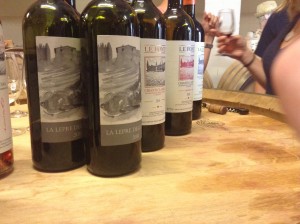
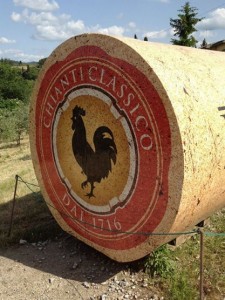
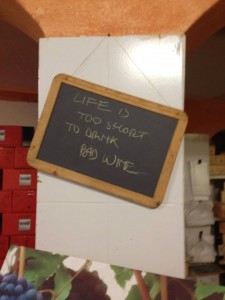
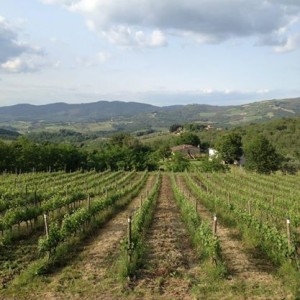
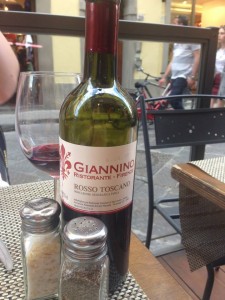
II. Flavor of Wines
Biological Vinicultures believe they have achieved better tasting wines because of their grape cultivation. They set out to grow grapes that are more controlled in their sugar production, helping in the development of physiological ripeness. Producers achieve this by encouraging competition among vines, forcing the plant to rely on the soil in order to get the nutrition it needs. This causes the grape vines to grow low to the ground to absorb the materials it needs. Many producers remove large quantities of grapes, so the vines can focus on making a select group of quality grapes. If this is accomplished, the wine has a more balanced alcohol and flavor content, even if there is a change in climate conditions. During fermentation, producers rely on spontaneous fermentation instead of yeasts that distort the flavor of the wine (Tamburlaine 2012).
In an article from Fortune magazine, wine experts sampled biological wines and their industrial counterparts to compare their flavors. The wine experts found that the biological wines were more expressive and represented their origin based on its texture, aroma, and flavor. This study concludes that biological wines are the answers to the gastronomic experience consumers want when they drink wine (Tamburlaine 2012).
III. Consumer Health
Also, biological wines will become more attractive to consumers because they are healthier for humanity. Farmers working in industrial vineyards suffer from respiratory and neurological problems, from spraying pesticides. The toxins in grape pesticides include: carcinogens, hormone blockers, neurotoxins, and reproductive or developmental blockers. The only chemicals that biological grapes are exposed to are sulfides and copper, which help protect the grape from extremely hot temperatures. Other additions to these wines are strictly biological including: animal manures, minerals, household wastes, plant wastes and algal preparations. Additionally, there are no of antibiotics or growth hormones exposed to the grapes to promote unnatural growth (“EU Rules for Organic Wine Production”2012).
IV. Supporting the Environment
At the same biological wines reflect the environment they reside in, because the vines play a key role in the ecosystem. Producers rely on the surrounding environment in order to protect the vines and promote grape growth; this could be the reason why these wines contain flavors that are reflective of their environment. The vines are grown with the natural fertility of the soil, no synthetic soluble fertilizers are introduced that cause water and air pollution. Similarly, there is a reduced irrigation system because the soil is promoted to maintain water, protecting against run off. Cereals and grasses promote a worm population that help this process and mix the soil around so it does not remain stagnant (Tamburlaine 2012).
With no pesticides sprayed, there are no animal deaths in the ecosystem. Moreover, the lack of presides promotes insects activity protecting the plant against more dangerous insects and diseases (Tamburlaine 2012). Traditionally, certain types of trees surrounding vineyards have been used to protect grape vines from pests. For example, rose trees are used to test the soil for fungi that cause serious disease. According to Luca Orsini, owner of Le Cincole (a biological wine producer), ‘Today, this is a new starting point for us—a way to continue our constant search for sustainable productivity: in favor of the environment and for our own benefit as producers who face a sometimes unscrupulous market that we’re deeply involved with day by day, (“Biological Wine in Tuscany” 2013).
V. My Experience in Panzano
At the forefront of this movement is Panzano, a small town in Italy. All of the producers in this town made a pact to grow their vineyards biologically. It has become a way of life for these producers, they are constantly looking for new ways to produce a wine that is reflective of their town but competitive in the global market. With the help of an agronomist (a person who studies the application of various soils and plant sciences to soil management and crop production) there have been studies on how to grow vineyards organically.
After living in Panzano for the last month, I have been inspired by the goal of the vineyards we have visited. In the United States, we are constantly told how important it is to purchase organic foods, but I have never heard about biological wines. After listening to the producers’ stories, I have learned they are truly grateful for the environment; grateful enough they will do anything to protect the environment for years to come. I am sure that each of these producers could make more money if they stuck to the conventional way of producing wine. However, these producers look at their grape like their own children, and are willing to put in the extra time in order to grow them naturally.
As a consumer who has tried these wines, I have begun to taste the artisanship and the environmental conditions that go into their production. I may not have a developed palate to taste every single nuance, but I can definitely taste a wine that reflects Tuscany and the environment of Panzano. When I go home, I will be able to share with my family the wine that I have purchased from these vineyards. Even though they have never visited Panzano, these wines will give them a glimpse of the experiences I have enjoyed. I believe this ability to transport consumers to different regions of the world will cause biological wines to dominate. Unlike industrial wines, consumers will be able to take a vacation through taste without leaving their homes. This will open up a dialogue among consumers about how different regions of the world bring their own spin on wine. This will leave behind wines that taste similar, and lead to embracing wine individuality.
VI. Conclusion
As consumers start to become more educated on biological wines there will be a change in current wine culture. As the health side effects of current pesticides are exposed, people are going to have to change their drinking habits to help their health. Similarly, people are going to have to embrace sustainable farming in order to help the environment. But most importantly, people are going to drink wines that are rich in flavor crafted by skilled artisans because they are going to love the stories that unfold as they drink it. Biological wines are going to act as a passport, allowing people to visit places like Panzano, helping them to better understand their culture. Ultimately, commercial wines are going to be a thing of the past.
Works Cited
“EU Rules For Organic Wine Production.” (2012): 5-45. Web. 4 June 2012. <http://www.itr.si/uploads/LW/AJ/LWAJRgGe_kylvigPDidvmg/ifoameu_reg_wine_dossier_201307.pdf>.
Goode, Jamie. “Improving Wine Quality with the Use of Biological Tools.” Lallemand. 2007. Web. 06 June 2014. <http://www.lallemandwine.com/spip.php?article432>.
Pellegrini, Paolo. “The Biological Wine of Tuscany.” Editorial. Firenze: Made in Tuscany 16 May 2013. Web. 6 June 2014. <http://www.firenzemadeintuscany.com/en/itineraries/this-week/in-vino-salus/>.
Privietera, Plania. “Organic Wine: Perceptions and Choices of Organic Consumers.” Academia. 2012. Web. 6 June 2014. <http://www.academia.edu/2120540/_Platania_M._Privitera_D._Organic_wine_perceptions_and_choices_of_Italian_Consumers>.
“What Is Organic?” Tamburlaine. 2012. Web. 06 June 2014. <https://www.tamburlaine.com.au/what-organic.html>.

